Striped bass are freshwater game fish that live along the east and west coast of the U.S. These fish have also been introduced to many inland states. Anglers use many methods to catch striped bass, including fly fishing, surf casting, spinning, jigging, bait fishing, and trolling.
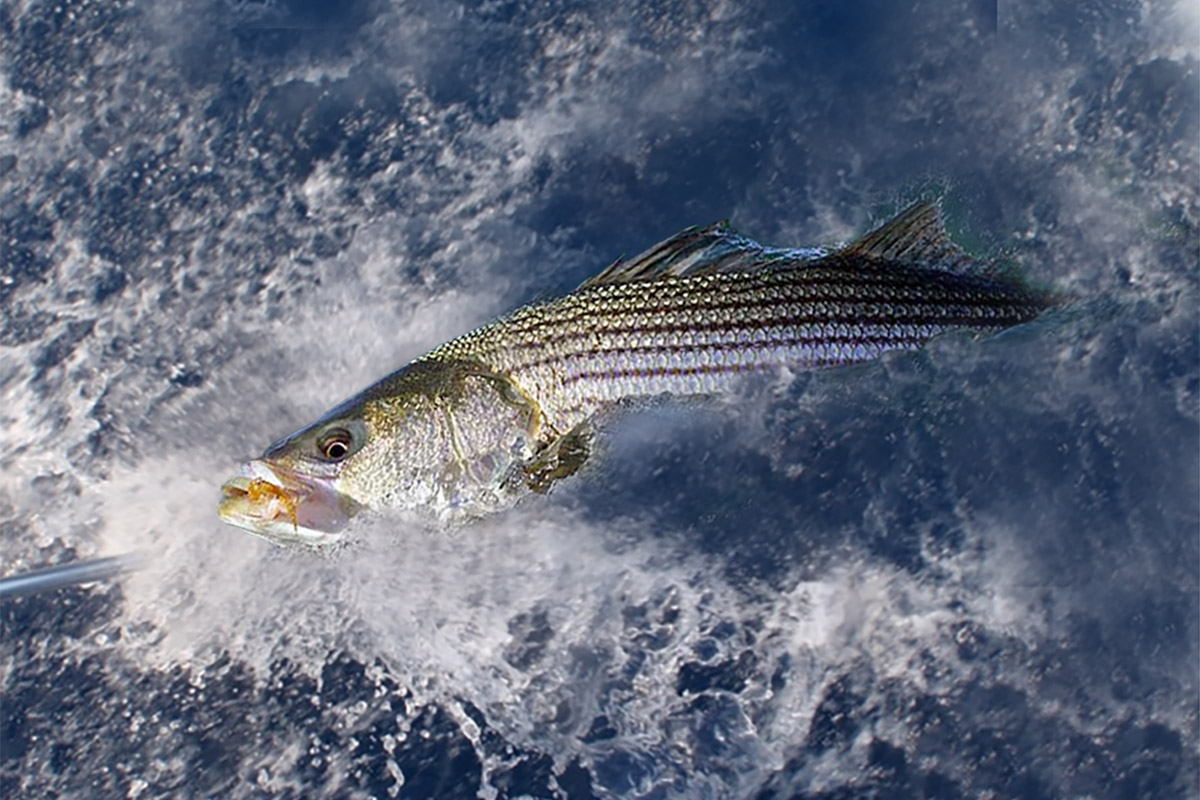
The following guide for anglers will you identify striped bass, learn where and when to catch them, provide some first hand tips and techniques for catching these fine fish, and introduce you the best types of baits and lures to get one on your hook.
- How to identify Striped Bass
- Where to catch Striped Bass
- How to catch Striped Bass
- Best Lures and Baits for Stripers
How to identify Striped Bass
As its name suggests, the striped bass is primarily identified by its stripes. Striped bass (or “stripers”) have 7 to 8 pronounced black horizontal stripes the run from the back of the gill to the tail along the scale rows on each side of its body. One distinct strip runs along the lateral line with the remaining stripes equally distributed above and below. Stripers are typically olive-green to steel blue or brown in coloration. Its underbelly is white or silver iridescent.
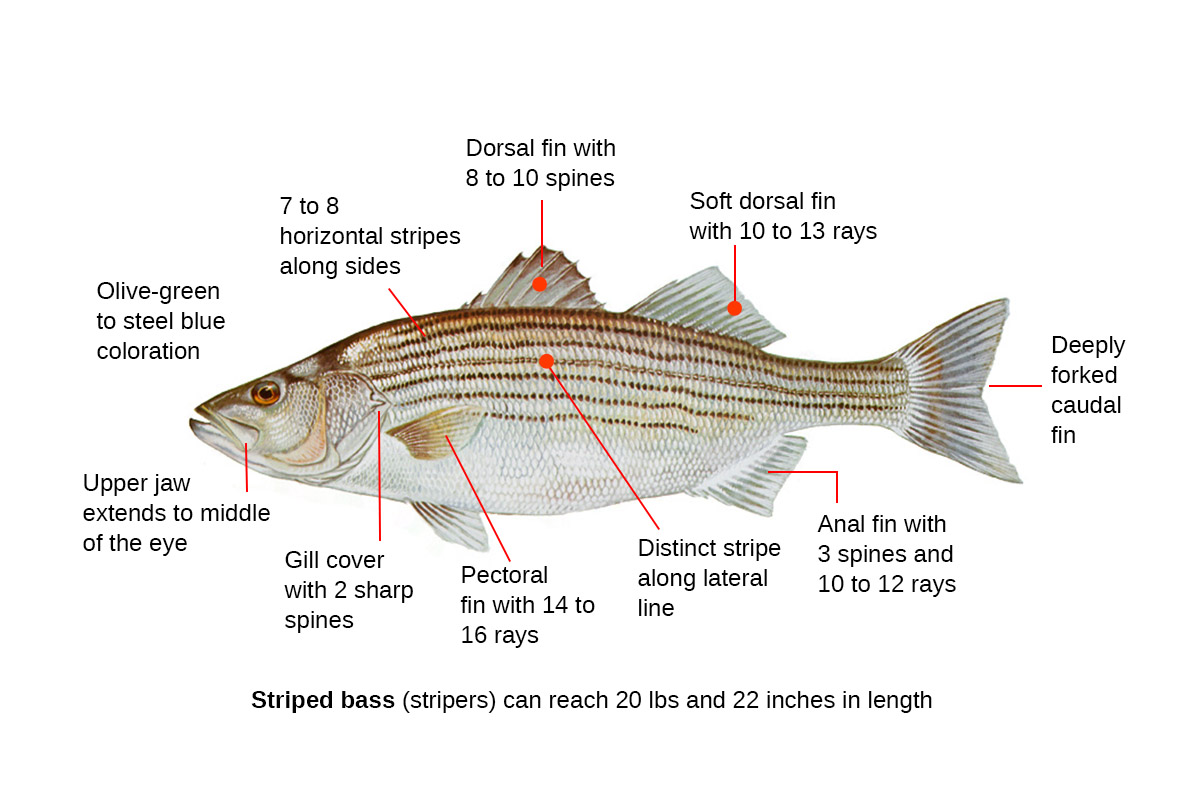
Striped bass have two pronounced dorsal fins. The first has 8-10 spines. The second has 10-13 soft rays. The pectoral fins of the striper have 14 to 16 rays. The anal fin has 3 small distinct spines at its from with 10 to 12 longer rays. The caudal (tail) fin of the striper has a pronounced fork. The dorsal, pectoral and tail fin are darker in coloration than either the anal or pelvic fins which tend to be a little bit lighter.
Striped bass are similar in appearance to its cousin the white bass. The two fish are often crossbred to create a hybrid the Whiterock bass. Striped bass are distinguished from white bass and hybrids by the regularity of the uninterrupted strips along its sides.
Striped bass can reach up to 5 feet in length and tip the scales at 70 pounds. An averaged size striped bass is between 20 to
Identifying characteristics:
- 7 to 8 horizontal stripes along sides
- Distinct strip along lateral line
- Olive-green to steel blue coloration
- Spiny dorsal fin with 8-10 spines
- Soft dorsal fin with 10-13 rays
- operculum (gill cover) with two small spines
A hybrid bass, also known as a Whiterock bass or a wiper, is created by cross-breeding a white bass and striped bass. Hybrid bass can be similar in appearance to striped bass and white bass. The easiest way to distinguish the striped bass from the hybrid bass is the lateral line. The lateral line on the striped bass is solid where the lateral line on a hybrid is typically broken. The main difference between the white bass and hybrid bass is that white bass have a single tooth patch on the tongue where hybrid bass have two.
Where to catch Striped Bass
Striped bass are found primarily along the U.S. Atlantic coast from Maine to Florida, and in the Gulf of Mexico. Striped bass inhabiting the Gulf of Mexico are a subspecies referred to as Gulf Coast striped bass. Striped bass are also be found from Washington to California along the U.S. Pacific coastline.
Striped bass are anadromous. They can live in both freshwater and saltwater environments. Most striped bass spend the majority of their life at sea and only migrate upstream into fresh water environments to spawn. Striped bass have been known to migrate up to 100 miles inland to spawn.
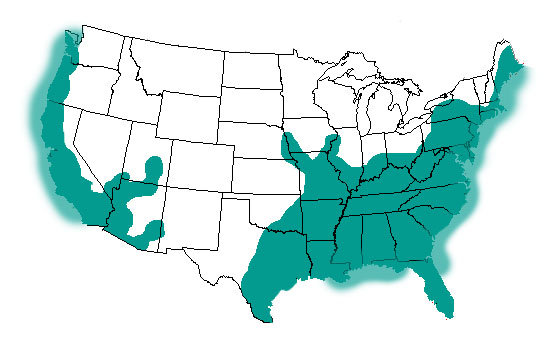
While primarily a saltwater species, striped bass readily adapt to freshwater environments which has lead to their stocking in freshwater rivers and lakes in many states to support recreational fishing. Landlocked species of striped bass have been introduced to freshwater lakes in California, Nevada, New Mexico, Utah, Texas, Louisiana, Colorado, and throughout the Southeast.
Landlocked species of striped bass struggle to reproduce naturally and still attempt to migrate upstream to spawn. Coosa River in Alabama and Georgia is one of the few freshwater environments in the United States where landlocked stripers reproduce naturally. Lake Texoma, on the border of Texas and Oklahoma also supports a self-sustaining population of landlocked striped bass.
The following are habitats where you can catch Striped Bass:
- Estuaries
- Birds
- Breakers
- Coastal Waters
- Current Edges
- Jetties and Breakers
- Outside of Bends
- Ripples, Currents, Swirls and Sprays
- Schools
Striped Bass Migration
Striped bass are a migratory fish species. They prefer water temperatures from about 50° F to 65° F and will move to find water within this range. Saltwater stripers migrate each spring and fall to spawn. Some of the best striper fishing occurs during these migrations. The largest striper migrations take place along the Atlantic coast.
Annual migration gets underway during the early spring as stripers move from deeper winter waters off North Carolina and Virginia and move north. As stripers migrate north, they visit the bays and freshwater rivers along the coast to spawn. During spring migration, Chesapeake Bay, Delaware River, and Hudson River are hotspots for striper spawning and fishing.
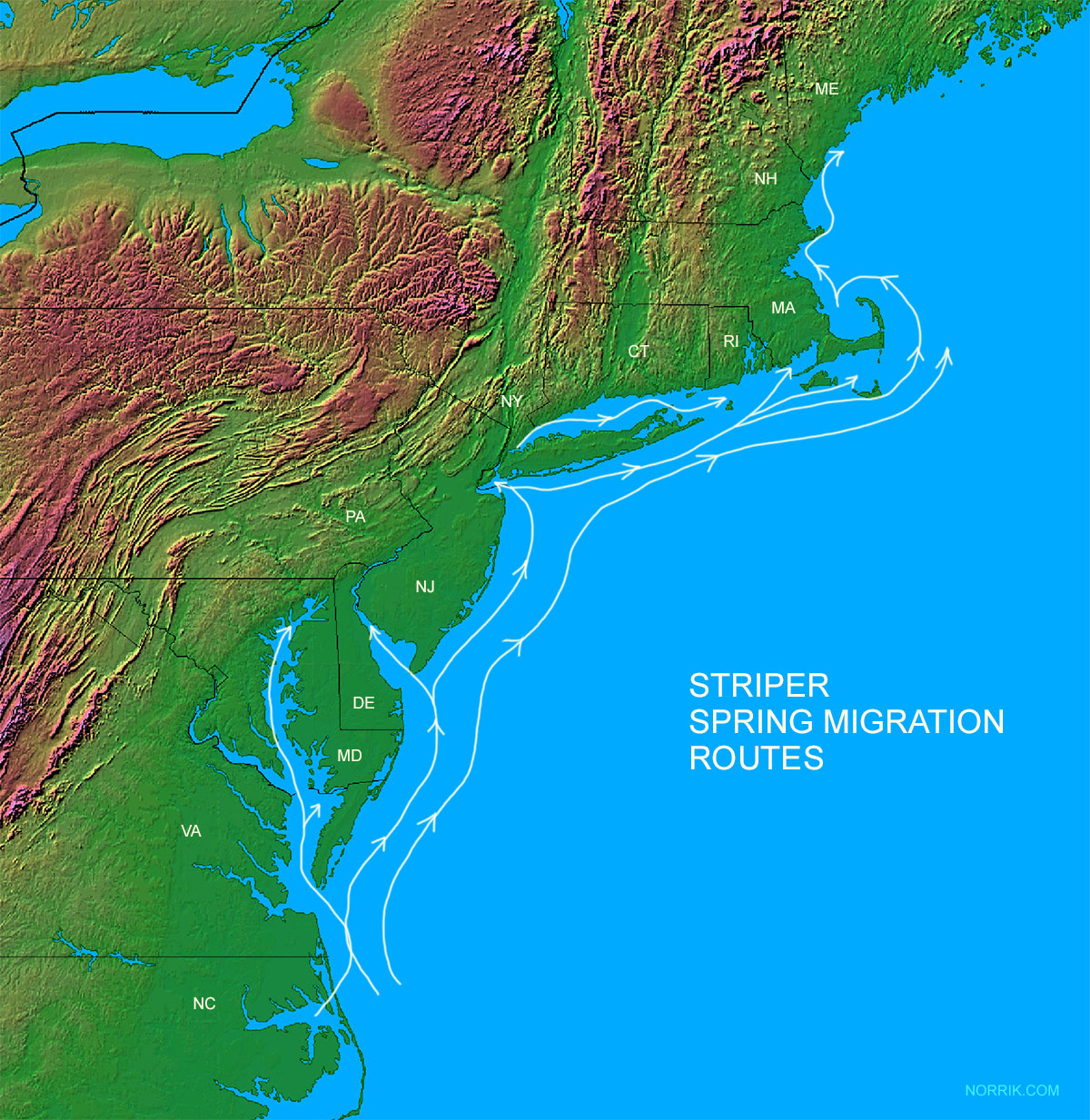
After their spring spawn, stripers continue their trek north to cooler waters off the New England and Canadian coasts.
As fall arrives, and waters grow cooler, stripers that have spent the summer off the coast of New England begin heading south to their wintering grounds. Striper fall migration often coincides with a variety of bait fish runs, including mackerel, peanut bunker, and silversides that are leaving the canals and bays for the open ocean.
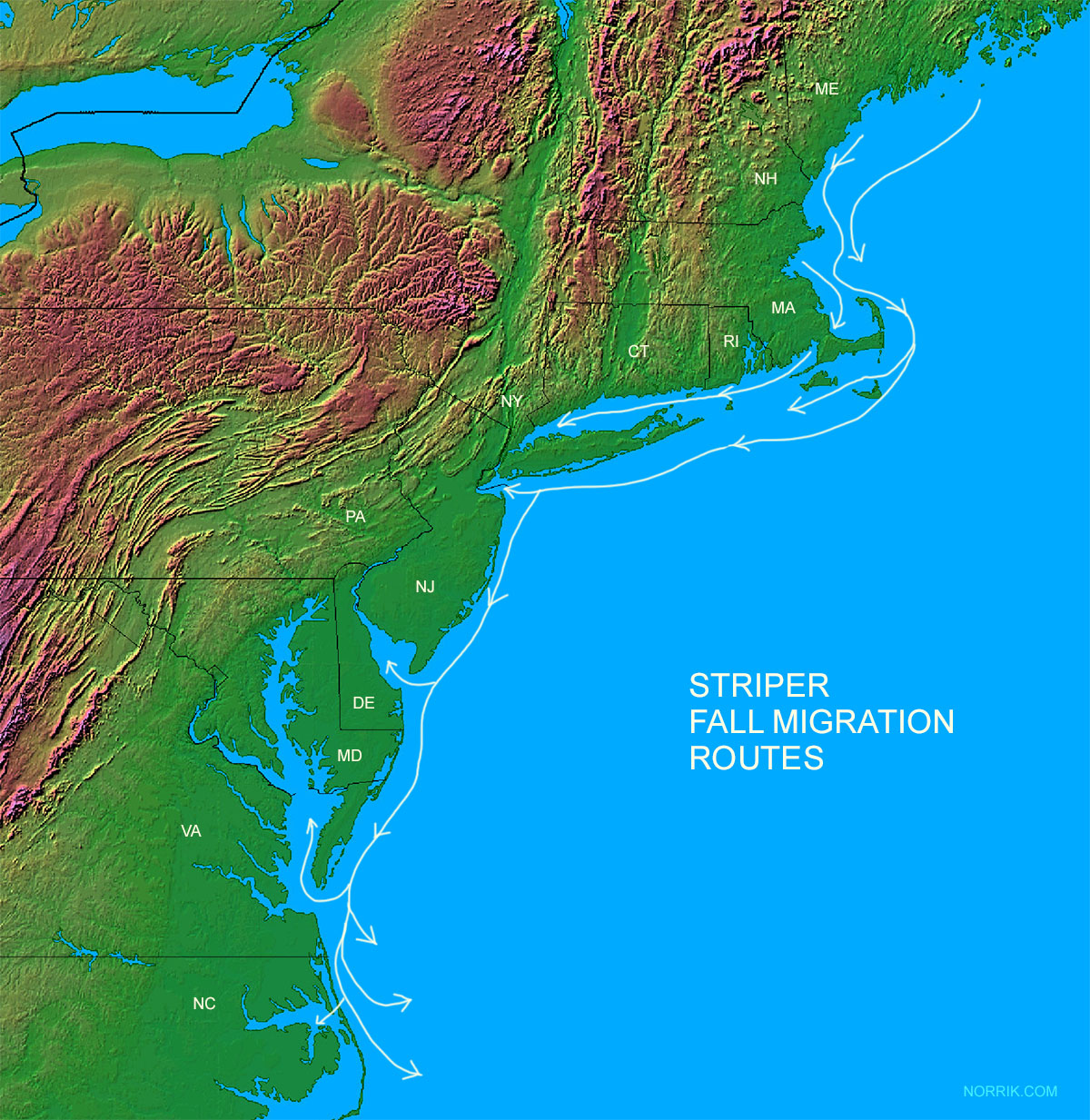
When migrating stripers come across baitfish runs, a feeding frenzy or blitz may occur. For the savvy angler, this provides a great opportunity to target stripers as they’ll take just about any bait in sight. Just look for the birds. The birds will lead you to the schools of baitfish. And where they’re baitfish, you’ll likely find striped bass feeding.
During their fall migration south, stripers will often move in close to the beach to pursue baitfish. During baitfish runs surf anglers may find hungry stripers feeding within casting distance. However, most stripers will stay outside of surf casting range—but within striking distance of boat anglers.
Fall migration of stripers may extend into December and even January as stripers reach the deep waters off Virginia and North Carolina. Migration routes for striped bass can be impacted by changes in water tempertures and storms. Make sure to check up-to-date fishing reports before your fishing trip.
How to catch Striped Bass – Tips & Techniques
Several methods of fishing and tactics are effective for catching striped bass. Some of the more common include fly fishing, surf casting, bait casting, jigging, and trolling. The most effective technique will depend on the where you’re fishing, water conditions, and size of the stripers you’re targeting.
Surf casting for stripers
Targeting stripers along the surf is most effective during migratory season when they’re moving in and out of estuaries and bays. During spring, stripers move in from deeper waters to scour the surf and feed before they spawn. During the fall they again feed along the shoreline before migrating to deeper water for the winter. Spring and fall are great times to fish the surf for stripers, but depending on the area you may find stripers year round.
A key to surf casting for striped bass is finding current. Once you find current you want to target the areas where the current breaks. Prime areas include where the surf is breaking against pilings, the pier, rocks, jetty, etc. You want to find the spot where the current is changing direction. During incoming and outgoing tides you’ll find a lot of current near inlets and canals—and stripers. Look for breaks in the current. Striped bass preserve energy by laying await where the current breaks while they watch for craps and baitfish to drift by in the current.
In some areas stripers can be found about 3′-10′ just offshore in what I refer to as the “grazing area”. This only requires the smallest pitch to get your bait in front of feeding striper. Other times stripers may feed over 100′ off shore, in which case you’ll need a long cast to get within striking distance.
When surf casting near shore, you can get away with using light tackle. When stripers are beyond the surf, you’ll need heavier tackle to get your bait out where they’re at and reel them in. For near shore surf fishing, I use a 2500 Daiwa BG reel on a Mojo inshore 7’6″ spinning rod, 20 lb braid main line, a 1 1/2 oz sliding egg sinker, with 2 feet of fluorcarbon leader attach to the main line using a barrel swivel. The egg sinker sits right above the swivel on the main line. If using bait, such as a sand flea—which I usually do—I’ll use a 0/8 or 0/9 circle hook.
Spinning reels are popular for surf fishing, but you can also use a conventional rod and reel setup. Conventional reels have a few benefits over spinning reels. They’re sturdy, reliable and are great for maximizing casting distance.
The most traditional presentation for surf fishing for stripers is the fish finder rig. It’s very similar to the setup I use. It gets your bait out in front of stripers, keeps it on the bottom, and creates a natural presentation by allowing bait to move freely in the surf.
Baitcasting for stripers
You’ll use a slightly different setup when baitcasting for stripers from a boat than when surf fishing from the shore. You can use either a casting rod or spinning rod when striper fishing from a boat. Casting rod/reel combos work well for fishing large swimming plugs, but when casting distance is critical, a spinning rod/reel combo is the better option. I’m partial to using a spinning rod and reel for striper fishing.
When I’m targeting stripers from a boat I’ll use slightly heavier tackle than when surf fishing. Most noteably I trade in my Dawia BG 2500 spinning reel for a 4500 series. Anything reel between 4000-6500 will work. And you don’t have to use Dawia. It’s just want I have.
Your rod size will be determined by your fishing style, presentation and target fish size. When spinning for stripers off a boat I’m going to be throwing a 3 to 4 oz weight so I like using a medium action rod. Some anglers go with a lighter action rod to improve sensitivity. I like medium action so I can get a little more leverage, and lifting power, on a big bass in current. I recommend a rod in the 7′-8′ range. If distance casting is the goal, go with a 9′ rod. Also remember, the bigger the fish, the bigger the rod.
There are a bazillion different lures you can use when baitcasting for striper. But I’m going to keep this simple. There are lures that float, suspend or dive, and lures that sink. You’ll want a couple of each for when spinning. The 4 lures I recommend ever serious striper angler keep on hand include:
- Topwater plugs
- Swimmers
- Softbaits
- Jigs
When using braid for your main line, always use a fluorocarbon leader.
When fishing for stripers from a boat you can fish many of the same places you’ll fish when surf casting, including mouths of inlets, breaking waves, sand bars, breakways, off jetties, and anywhere else you find breaks in current. During high tide hit the tidal shallower areas in estuaries and bays. On outgoing tide fish the deeper channels in areas where there are breaks in the current. Stripers often hang out on the on down-current and up-current sides of offshore rips where baitfish and squish are abundant.
The following diagram shows the basic approach to fishing current for stripers.
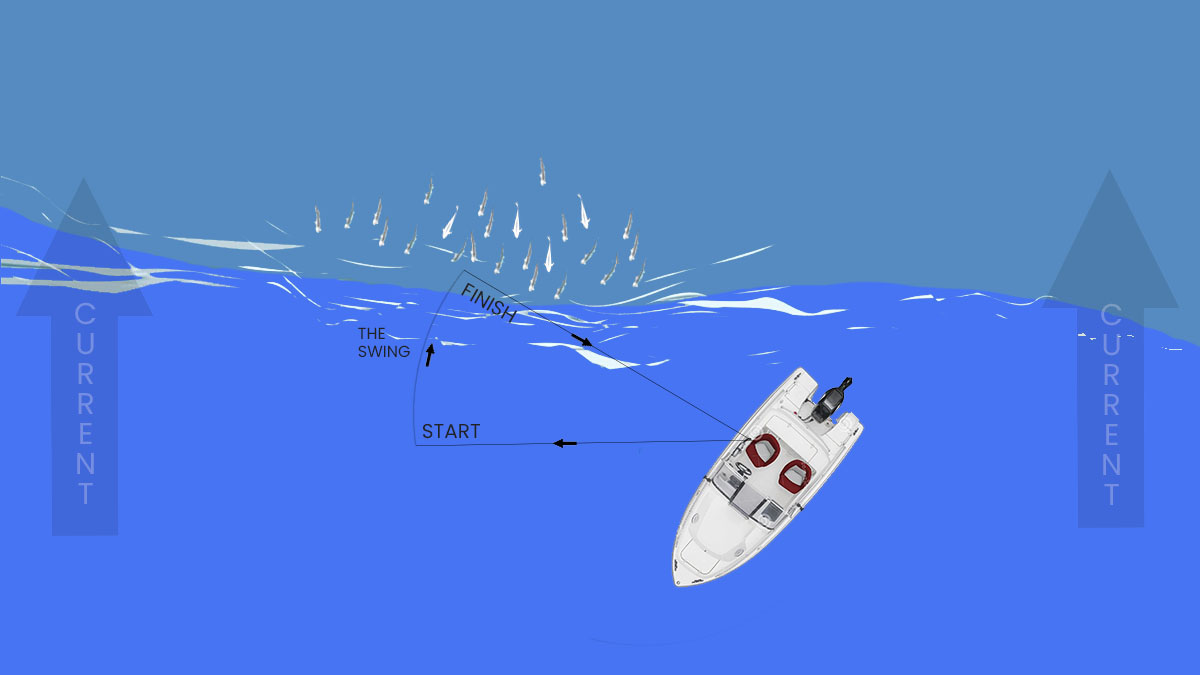
The biggest advantage of fishing from a boat is you’re able to access more prime striper fishing spots.
When targeting stripers from a boat, always be aware of your surroundings. Stripers like current, but current is dangerous. Try to keep your boat out of the current, but near enough you can reach the stripers with a well placed cast.
Fly fishing for stripers
Fly fishing for stripers is quite a different experience than surf or bait casting for stripers—but you can’t beat it. What make stripers such a good target for fly fishing is that they often live in just a few feet of water and can be found feeding all the way up to the shoreline.
In contrast to areas with current, flats are excellent habitat for targeting stripers flyfishing from a boat. On the flats you can sightfish stripers just like you would permit or bone fish. Place your bait just upcurrent of a single striper or pod, and allow the current to swing the fly down in front of striper. This action imitates a fleeing baitish. Best way to get a striper to strike.
Bringing the right rod is key. For fly fishing, I recommend a 7-9wt 8-9′ rod. I prefer the heavier weight and length fly rods for tackling the larger females. You want a rod with some backbone so that you can handle those lunkers.
The striped bass can be caught year round day or night, but the best times to look for them—especially during the warmer summer months—are in the early morning and evening. During these times, they tend to stick closer to the surface, making them easier to target when fly fishing.
Vertical jigging for stripers
If you want to hook some real trophy class stripers in the 40 to 50 pound range during the warmer months, you’ve got to go to deep water. And there’s no better way to get down deep than vertical jigging. Of all the ways to hook a striper, vertical jigging is my favorite.
Vertical jigging is a simple technique where you cast and let you jig lure sink to the bottom. Wait until you feel your lure hit the bottom, count a few seconds, then snap the lure up quickly and allow it to drop back to the bottom again. This active fishing techique is really effective for catching striper bass.
I’ve found the best depth for vertical jigging stripers is between 30 and 70 feet, although you can often find them shallower or deeper. The best area to fish for stripers is where there’s structure and a little current. Stripers will hold along structure or dropoffs and this is where you want to target. Scour the area using your fishfinder to find where bass are holding and drop your line.
Selecting the right jig is just as important as finding the right area. Shape, color, size, pattern… they can make or break a fishing trip. Typically, you want to stick with bright color lures on bright days and dark color lures on dark days. When selecting lures, try to match the hatch. Match the size and profile of your lure to the natural forage. Lures that simulate injured or dying baitfish work well. Striped bass are opportunistic feeders and will readily take a lure that looks like a injured baitfish.
Your bait casting gear will work for vertical jigging, but if you plan on doing much jigging for strippers you real need a dedicated jigging rod. A vertical jigging rod is shorter and provides more moderate parabolic action than a casting rod. It allows for better control, maintains a better vertical position above the lure, and makes it easy to sense subtle strikes.
Drift fishing for stripers
It doesn’t get much more basic than drift fishing for stripers. It’s a tried and true technique that gets results—and many anglers swear by. The biggest benefit of drift fishing is it allows you to fish an entire area of structure, where jigging limits you to fishing one spot.
Once you’ve identified the structure you want to fish, position your boat about 200 feet up current from the structure. Make sure the bow of the boat points up current. Allow the current to take you down over the structure. Drop you rig or lure down ’till it hits the bottom and then reel up a turn or two so it’s slightly above the bottom. Let the current do the rest.
There several presentations that can be used when drifting for stripers. One of the most common is a three-way swivel rig using bait. A simple bucktail jig is also effective for hooking stripers.
Trolling for stripers
Trolling is one of the most effective techniques for targeting predator species including stripers—especially when they’re scattered throughout an area. It’s also a useful technique for finding stripers when you’re not sure where exactly to drop your line. The basic premise of trolling is quite simple, toss some lures behind your boat and start pulling them through the water. However, there’s a lot more to it.
- When to use trolling?
Trolling is a good fishing technique to use when the weather is hot, or the sun is bright, and bass head for deeper water. When you see birds feeding on schools of baitfish at the surface, troll the edges matching the hatch to get stripers to strike. Troll areas that have traditionally held bass to see if they’re present, then move on if you don’t get a bite. - Where to you troll?
For trolling to be productive you need to troll areas where stripers are holding. Striped bass tend to hold in areas with structure, such as rocky bottoms with boulders and rock piles, natural or artificial reefs, drop offs, and edges of rips where they can ambush baitfish and prey. - What lures to use?
There are myriad of lures that can be used for trolling. As a rule of thumb, always try to match the hatch. Stripers aren’t terribly picky, but your strike rate will be higher if your lures mimic their natural prey. If stripers are used to eating sand eels, and you present a parachute jig resembling a squid, you may not get as many bites. This isn’t always the case, but a good general rule. - How deep should you troll?
Your trolling depth is going to depend in large part on where the fish are holding and the contour of the water. You don’t always need to drag the bottom. When fishing over structure 40′ down, you want your rigs right on top at about 35′ deep. If trolling the edge of a rip using wire, 10′-15′ is probably a good depth to be at.Make sure you let out the right amount of line for the depth. At standard trolling speeds of 2-3 mph, for every 1′ of depth you want about 10′ of line in the water. If you’re trolling for stripers at a depth of 30′ you’ll want to let out about 300′ of wire. If you want to go deeper (1) let out more line and (2) increase the weight of your lure. To get to a depth of 30′ you’ll need to let out 300′ of line using 3-4oz jig. If you need to go deeper, or there is substantial current, you’ll need to let out more line, increase your jig weight, or possibly slow your troll speed.
- Setting the drag.
Setting the correct drag is an important element of trolling for stripers. If your drag is too tight you’ll rip a hole in the side of the fish’s mouth when it hits the hook—especially if you’re using wire. Remember, wire doesn’t give. Conversely, if your drag is too loose, and slack develops in the line, the fish can wiggle free of the hook and escape. - How fast do you troll?
Trolling speed is determined by the type of rig your fishing and the boat. When fishing a tube and worm rig, a good trolling speed is between 2-3 mph. You want to up the speed to 3-5 mph when trolling an Umbrella rig. If you go against the current, you can slow your trolling speed to 1-2 mph and allow the current to carry your rig. Trolling against the current can be productive.Trolling in a straight line isn’t always the best strategy. You should experiment with changing up your trolling speed and patterns. Throttle your speed up and down. Stripers will often hit your line just after or before you change trolling speed. Try trolling in a zigzagg pattern.
- What do you do after a hook up?
Every time you hook a striper, pay attention to the conditions of the hookup. You want to learn what worked, then duplicate the technique. Were you speeding up or slowing down when the strike occurred? Were you traveling with or against the current? Were you fishing over structure? What color and type of lure was used? - Best rods and reels to use for trolling
Trolling rods for stripers first and foremost need to be strong. They need to be able to resist the pressure exerted by the boat, the stress created by dragging a rig, and the strength required to reel in a giant striper. For striper trolling I recommend a conventional rod and reel combo with a level wind reel. The level wind reel is optional but is beneficial for trolling.A level wind reel uses a moving line guide to ensure the line wraps evenly on the spool and doesn’t build up in one spot. Non-level conventional style reels do not have a line guide. The angler is reponsible for making sure the line wraps evenly on the spool during retrieval. I wouldn’t necessarily recommend a wind reel for other fishing applications, but for trolling I really like using one.
A good general rod size for striper trolling is a 7′-8′ medium-fast to fast action rated for 30-50lb monofilament line. For striper trolling there are three rod types I’d recommend: wire line jigging rod, short lead core rod, and long lead core rod.
Other popular methods for catching stripers include fishing with spoons and night fishing.
Best Lures and Baits for Stripers
Striped bass are opportunistic feeders and will readily take a variety of live bait or artificial lures. Crabs, sand fleas, bloodworms, squid, clams, eels, menhaden, shad, spot, perch, mackerel, and alewives are all on the menu. For targeting larger bass, live eels, spot, bunker, and herring are your best baits. Cut bait, including fresh or frozen fish, works well for striped bass of all sizes.
A few of the more effective artificial lures include plugs, flies, jigs, crankbaits and casting spoons. To maximize strike rate, try to match the hatch. Using artificial lures that match the local forage and baitfish will increase strike rate.



